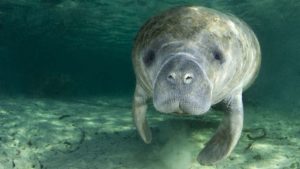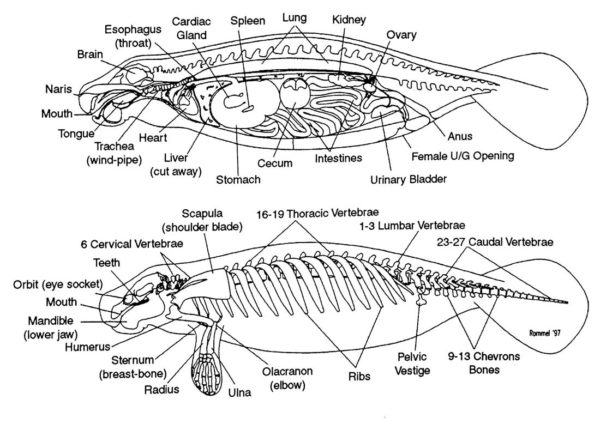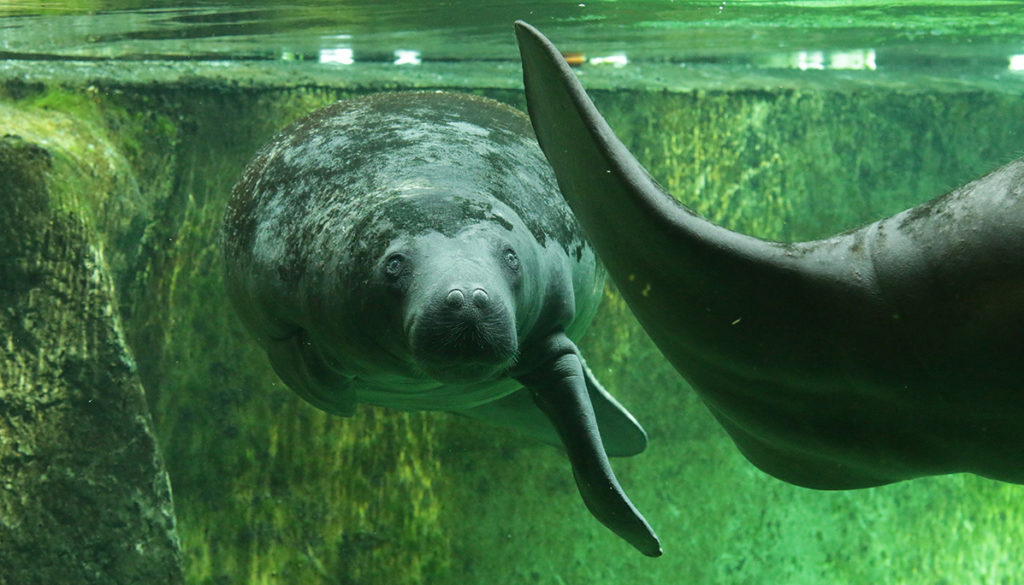The Manatees or sea cows, (Trichechus genus), are slow-moving aquatic mammals found mainly along the tropical and subtropical Atlantic coasts. Discover why despite being such peaceful beings, they are threatened to disappear from the seas of the world.
These gentle herbivores spend most of their time searching and ingesting riparian plants and the shallow waterbed. Manatees live in both sweet and salty waters, near the coasts of America and Africa. Let’s now know more about them.
Table Of Content
Main Characteristics
It´s important to start by mentioning that the name «manatee» comes from a Caribbean indigenous language meaning «with breasts». These tropical creatures have an aerodynamic body, which is very robust in the middle portion, while it narrows towards its back and ends in a tail shaped like a paddle which they employ to swim with up and down movements.
All these traits are evolutionary adaptations of the species to the aquatic environment. In terms of their body´s color it is mainly gray, although brownish gray colorations may appear. However, the Amazonian manatees (Trichechus inunguis) are also gray, but they have white spots and sometimes pink on their chest and belly.
The skin of all manatees is very thick and rough, and has a layer of fat that protects them from low temperatures. Moreover, some marine organisms such as algae usually adhere or grow on their bodies making them appear greener and even in some cases brown.
They also have scattered hairs all over their body, most of them in the area of their snout, very similar to those of seals. It is important to point out, that Manatees are only aquatic creatures since their forelimbs have become fins. In the case of specimens from Western Africa and India (Trichechus senegalensis) they have three or four fingernails similar to that of elephants at the tip of their fins, while the specimens of the Amazon lack nails.
Mouth
Manatees have a mouth very different from that of other marine mammals, since they have a large upper lip that is divided in the middle, and both sides can move independently, which allows them to grab the plants, and guide the vegetation towards the mouth. In addition, they have twenty-four to thirty-two molars in the posterior jaw. The front molar teeth are usually worn out due to the abrasion of the plants that they consume, but others grow in the back of the mouth, and move gradually to the main row
Senses
The marine cows don´t have neck and their small eyes, (2 centimeters in diameter) are covered by a nictitating membrane that protects their eyeballs. However, they have a surprising visual acuity and are able to distinguish objects of different sizes and patterns. Behind each eye they have a small opening that is their auditory canal, (they don´t have ears) being this along with their sense of touch, their most developed senses.
They also have nostrils on their head which are located at the end of their snout, just on the upper surface. When the manatees submerge, they automatically close their nostrils to prevent the entry of water through them.
Size
The manatees weigh from 400 to 550 kilograms and have an average length of 2.8 to 3.0 meters even 4.6 meters in some occasions. It can be said that this species presents sexual dimorphism since females tend to be larger and heavier. At birth, baby manatees weigh approximately 30 kilograms each.
Here they are
Habitat
Of the three species of manatee, two live in the Americas and one in Africa. They prefer warm shallow waters (27 º c or more) such as slow rivers, estuaries, salt water bays, canals and coastal areas – particularly where sea grass meadows or freshwater vegetation proliferate. During winter, they migrate to places where they can get warm waters, which is why they are considered a migratory species.
For example, in the United States they tend to move to the coast of Florida during winter, where many tourists who already know these habits await to enjoy them. These interesting animals are characterized by being very quiet and spend most of their lives sleeping and eating what they find in their habitat. However, if food is scarce they are able to look for it in deeper waters, or in more severe cases, they have to emigrate.
Distribution
The three species of manatees that exist are distributed in different parts of the world.
Caribbean or Florida (Trichechus manatus)
They are distributed throughout the southwest and northwest of the Atlantic Ocean, in the Caribbean Sea, in the Gulf of Mexico and its adjacent waters where they usually migrate during the winter months. They are present in thirty-seven countries of the American continent, thriving mainly in the Caribbean Sea, which is the reason of their names.
Trichechus sanegalensis
This species is only found in the United States, specifically in Florida, although some specimens have been sighted in the Bahamas. Since they prefer warm waters, they inhabit mainly in North Carolina, South Carolina, Georgia, and Virginia.
Trichechus inunguis
Better known as the Amazonian manatee, it is only found in the Amazon River, and therefore in Venezuela, Colombia, Brazil, Ecuador, and Peru, having a greater presence in the Brazilian territory.
When the water temperature is very cold, manatees seek shelter in areas that can offer warmer, or even mild waters. These mammals have evolved so much that many of them are able to tolerate changes in salinity from sea water to fresh water, but not the other way around, so the Amazonian manatee can´t inhabit the seas.
Let´s meet them
Https://www.youtube.com/watch?v=kqnVHNGKDlY
¿What Do Manatees Feed On?
Manatees are herbivores creatures which feed on a variety of submerged, emergent, floating, and shoreline vegetation. Turtle grass, manatee grass, shoal grass, mangrove leaves, various algae, water hyacinth, acorns, and hydrilla can be mentioned as the main components of their diet. However, some specimens have been reported eating foods other than plants, like fish and clams.
They consume about 4% to 9% of their body weight in wet vegetation daily. However, it’s known that the Amazonian Manatees apparently fast during dry seasons (November and December) when water levels drop as much as 9 to 15 m eliminating their access to vegetation. Their front flippers and large flexible lips are their main and most useful tools to manipulate vegetation.
¿How do Manatees in Captivity Live?
Thanks to their passive behavior with humans and other species, manatees adapt very well to life in captivity. They only need the proper conditions in terms of temperature and food, so that they live as if they were at home.
There is a documented case of a manatee named Presumida, which lived for fifty years in captivity and many others that are now also in aquariums around the world.
The problem of this lies in females, since when captured; captivity produces such a level of stress that doesn´t allow them to mate, until several years have elapsed after their capture. The worst thing is that females of this species only mate every five years so the hope of procreating new species is really very low.
¿Why are the Manatees in Risk of Extinction?
These animals that have been living in this world for more than sixty million years don´t have natural predators despite being so voluptuous. However they are one of the most threatened marine mammals and are currently in danger of extinction. If the appropriate measures are not taken to preserve this species, it is very possible that it disappear.
Threats
Due to their long life cycle (around 40 years ) and their low reproductive capacity, manatees are very vulnerable to persistent hunting to market their meat, fat, leather and bones. In the middle of the last century their hunting became very intense, but nowadays it seems to be decreasing although the number of deaths registered monthly is greater than the annual births that are documented.
Among other threats, their deaths have been reported in fishing nets, collisions with motor boats, the alteration of their habitat to build dams, the draining of wetlands, the mangrove forests’ deforestacion and pollution.
At present, several measures are being taken to prevent this species from disappearing forever. For this reason, different regulations have been created to prevent their pursuit and capture and reserves have been created for them, with the Rio Dulce Reserve in Guatemala being one of the most recent creation.
A study conducted last year, by the Geological Survey of the United States, explained that the situation of manatees is quite serious and if the necessary measures are not taken in a short time, their possibility of recovery will unfortunately disappear.
The last wildlife reserves, where manatees can be found today are: Rio Dulce in Guatemala, Cuero y Salado in Honduras, Chetumal Bay in Mexico, Estero Hondo in the Dominican Republic, Tortuguero National Park in Costa Rica, and Turuépano National Park in Venezuela.
Conservation:
In the different countries where these creatures live, several measures have been taken for their preservation such as those detailed below:
1- Application of different laws for the protection of manatees,
2- Education and awareness of local populations to the needs of the protection of manatees. Many of these measures are aimed at fishermen to prevent them from hunting the manatees and even to support their rescuing tasks.
3- Development of research projects on the species, to generate knowledge about manatees specific to each country. Current projects focus in particular on counts to estimate the population, behavioral studies both in captivity and wildlife, genetic studies and animal health assessment.
4- Protection of the manatees´ habitat and creation of protected areas.
5- Rescue actions for injured or orphaned individuals for their rehabilitation and re-introduction to their habitat
Curious Facts About Manatees
¿Did you know why manatees can spend so much time without coming to the surface to breathe?
These animals like many other mammals, spend a lot of time eating underwater, so they must hold their breath for the necessary time to feed themselves. The manatees also rest submerged in the water, and they emerge to breathe every three or four minutes to the surface.
When manatees employ more energy they tend to emerge every thirty seconds, but some of these mammals have been submerged even for twenty minutes and this is because they have certain adaptations that allow them to stay longer underwater. In the case of manatees, each lung is in a separate cavity.
It isn´t known for sure if their lungs work independently, but it has been proven that a manatee can have an infection in one of their lungs, while the other works in a normal way. They can also renew around 90% of the air contained in their lungs in a single breath; and if this seems few human beings can only renew ten percent per breath.
The nobility of these creatures reaches a point that they prefer to die rather than abandon a wounded companion. When this happens, the herd gathers around and emits pitiful moans.
Swimming Behavior
As we mentioned earlier, manatees are slow animals that usually move between three and five miles per hour. They prefer the shallow waters, between ninety centimeters, and two meters deep although when they don´t get food, they can submerge up to twenty meters to find them. These animals are usually solitary, and some of them are more willing to travel than others. It is known that these mammals can travel on a day about forty-five miles, and if they have any extra incentive, such as food or females, they may travel much more than that.
¿How do Manatees Communicate With Each Other?
It is known that manatees emit sounds under water, which are like a sort of code to communicate with each other. It´s believed that such sounds can express anguish or fear, anger, and excitement, and are mostly used when they are searching for food in very murky waters, or when the mother cares for her young.
These sounds can be described as squeaks or whistles, which can reach a range of 3 to 5 Khz, and have their origin in their larynx. It is very likely that they perceive them in the cheekbones of the face which are in close contact with the bones of the ears. Thus, it is believed that manatees, like dolphins, are anatomically adapted to listen to very low frequencies, which the ear of the human being isn´t able to perceive.
Let´s hear them
Reproduction:
The manatees’ reproduction rate is low since they are not sexually mature until around five years old. It is believed that a baby is born every two to five years and the gestation period is 13 months. Mothers breastfeed their young for one or two years, during which time a calf continues to depend on its mother.
The couples only come together to mate, and the mothers are the only ones responsible for the offspring, because before they are born, the male separates from the mother. Baby manatees are born underwater. Mothers must help their calves surface so they can breathe for the first time, but babies can usually swim alone one hour later. They eat water grasses, weeds and algae, and many of them. A manatee can eat a tenth of its own weight in just 24 hours.
Friendly Animals
Despite their intimidating size, manatees aren´t even possessive and much less territorial. They are able to share the environment where they develop with other species and cohabit in harmony. These mammals are not aggressive since they don´t have natural enemies and even with their only predator they are usually sociable.
Although they are solitary creatures, they usually make groups to migrate and feed themselves without structure or leadership, nor can they distinguish between age and sex. They are docile, curious, and friendly creatures, and because of these characteristics they are easy prey for their hunters.
Unfortunately, despite the locations that have been created to care for manatees, the sanctions that are applied to hunt them are flexible, and the people who are in charge of enforcing the laws do not put a strong hand on the offenders. Remember that biodiversity is essential for our much-abused planet. We can enjoy all the animal and vegetable species that it offers us without abusing consumption or over exploitation












